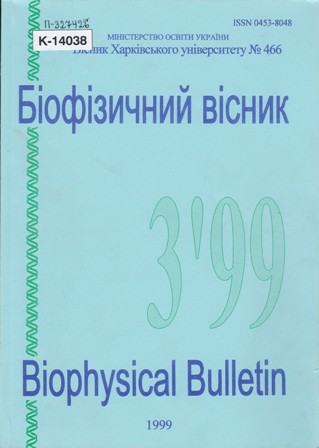EFFECT OF Mg^2+ ON DOUBLE AND TRIPLE HELLX FORMATIONS BETWEEN POLY(dA) AND POLY(dT)
Abstract
The Mg2+ ion effect on conformational transitions in double- and triple-helical structures formed by poly(dA) with poly(dT) has been studied in 10 mM cacodylate buffer, pH 7, containing 0.1 M Na+. The investigations were carried out by the method of thermal denaturation using UV absorbance and Rayleigh light scattering detections of melting transitions. Temperatures of helix-to-coil transition of poIy(dA)-poly(dT) and triplex-to-duplex of poly(dA)-2poly(dT) increase linearly with log[Mg2+] and more quickly in the last case that results in superposition of these transitions at [Mg2+]>15 mM. At [Mg2+] > 20 mM during the melting of the both structures aggregation was observed, which arised, according to Bloomfield and co-workers, due to formation of cross-links by Mg2+ ions bridges between partially unplaited polymer strands and disappeared after the end of melting. It is established that at the presence of 0.1 M NaCl magnesium ions do not induce the partial formation of the triplex structure in poly(dA)poly(dT) (disproportionation) as is postulated by other authors in some papers.
KEY WORDS: polynucleotides, double and triple helices, magnesium ions, helix-to-coil transitions, Rayleigh scattering
Downloads
References
2. Hopkins H.P., Hamilton D.D., Wilson W.D. // J. Chem. Thermodynamics. 1993. V.25. P.111-126.
3. Sehlstedt U., Aich P., Bergman J., Vallberg H., Norden B. and Graslund A. // J. Mol. Biol. 1998. V.278. P.31-56.
4. Duguid J.G. and Bloomfleld V.A. // Biophys. J. 1995. V.69. P.2642-2648.
5. Shibata J.H. and Schurr J.M. // Biopolymers. 1981. V.20. P.525-549.
6. Crothers D.M. //Biopolymers. 1971. V.10. P.2147.
7. Anshelevich V.V., Vologodskii A.V., Lukashin A.V. and Frank-Kamenetskii M.D. // Biopolymers. 1984. V.23. P.39-58.
8. Pilch D., Brouseau R. and Shafer R.H. // NAR. 1990. V.18. P.5743-50.
Authors who publish with this journal agree to the following terms:
- Authors retain copyright and grant the journal right of first publication with the work simultaneously licensed under a Creative Commons Attribution License that allows others to share the work with an acknowledgement of the work's authorship and initial publication in this journal.
- Authors are able to enter into separate, additional contractual arrangements for the non-exclusive distribution of the journal's published version of the work (e.g., post it to an institutional repository or publish it in a book), with an acknowledgement of its initial publication in this journal.
- Authors are permitted and encouraged to post their work online (e.g., in institutional repositories or on their website) prior to and during the submission process, as it can lead to productive exchanges, as well as earlier and greater citation of published work (See The Effect of Open Access).





